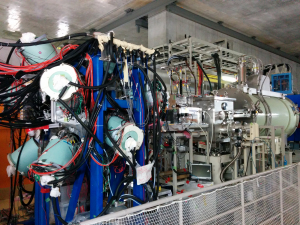An experiment led by the Institute of Corpuscular Physics (CSIC-UV) challenges a key principle of nuclear physics
An international scientific collaboration led by the Institute of Corpuscular Physics (IFIC), a joint centre of the Spanish National Research Council (CSIC) and the University of Valencia (UV), has made a surprising discovery that questions a fundamental principle of nuclear physics known as isospin symmetry.
This symmetry is a key concept that explains why protons and neutrons — the two particles that make up an atomic nucleus — behave very similarly despite having different properties, such as electric charge. Thanks to this symmetry, it was expected that pairs of so-called “mirror nuclei” — which have the same total number of protons and neutrons, but swapped like the left and right hands — would share identical quantum properties, especially in their ground state, which is the most stable and natural configuration of the nucleus.
However, the new study has found for the first time that this symmetry does not hold in all cases. Specifically, researchers observed that the nucleus of Krypton-71 (⁷¹Kr) and its mirror nucleus, Bromine-71 (⁷¹Br), have different ground states, despite differing by just one proton and one neutron. This finding reveals an unexpected breaking of isospin symmetry in such closely related nuclei. The results have been published in the leading physics journal, Physical Review Letters.
Fundamental principle
Since the 20th century, when the proton and neutron were identified as the fundamental building blocks of the atomic nucleus, nuclear physics has advanced thanks to increasingly precise models. A concept introduced by Werner Heisenberg and refined by Eugene Wigner, useful both in nuclear and particle physics, is to consider protons and neutrons as two states of the same particle: the nucleon.
This assumption leads to isospin symmetry, which predicts that mirror nuclei should share identical quantum properties, especially in their lowest energy states or ground states — the ‘natural’ mode of a nucleus if not excited or disturbed by an external interaction.
However, the study led by IFIC shows that this is not always the case. In particular, it demonstrated that the nucleus of Krypton-71 (⁷¹Kr) has a different ground state than its mirror nucleus, Bromine-71 (⁷¹Br), contrary to what was expected.
Krypton-71 (⁷¹Kr) and Bromine-71 (⁷¹Br) are a pair of mirror nuclei because their proton and neutron numbers are swapped: Krypton-71 has 36 protons and 35 neutrons, while Bromine-71 has 35 protons and 36 neutrons. What this work shows is that the isospin symmetry is slightly broken: these mirror nuclei do not behave exactly the same, even though they differ by only one nucleon. “This is the first documented case of isospin symmetry breaking in such closely related mirror nuclei, where only one nucleon is swapped,” explains Alejandro Algora, CSIC researcher at IFIC and lead author of the study.
Other breakings in more exotic nuclei
The finding is based on a subtle rearrangement of energy levels inside the atomic nucleus, which the research team has been able to explain through theoretical calculations using the shell model. In nuclear physics, the shell model is a way to understand how protons and neutrons are organised and behave within the atomic nucleus. Just as electrons arrange themselves in shells around the nucleus, protons and neutrons also group into levels or ‘shells’ inside the nucleus, like floors in a building.
The project that led to this surprising discovery, initially conceived by a research group from Spain and Italy, was carried out within the framework of a broad international collaboration at the RIBF radioactive ion beam facility at RIKEN (Japan), one of the world’s most advanced centres for studying exotic nuclei, in this case radioactive nuclei with extremely short lifetimes.
This discovery opens up new research possibilities. “It is possible to explore this kind of breaking in even more exotic nuclei,” says Algora. In fact, this topic was recently discussed at an international workshop organised by IFIC itself, where possible future experiments at the RIKEN radioactive ion beam facility were considered. Thus, “this finding reinforces IFIC’s role at the forefront of international nuclear physics,” concludes the CSIC researcher.
References:
A. Algora et al., Isospin Symmetry Breaking in the 71Kr and 71Br Mirror System, Phys. Rev. Lett. 134, 162502 (2025). DOI: https://doi.org/10.1103/PhysRevLett.134.162502




















